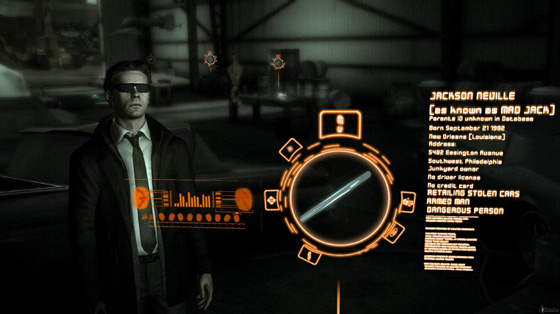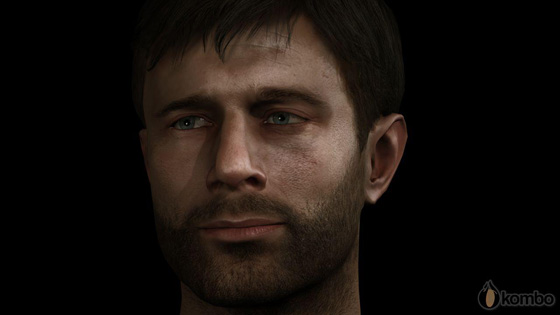Design Discussions: Deconstructing the Video Game: Three Pillars of Design for Interactive Drama (Heavy Rain)
July 13th, 2010

[‘Design Discussions’ is a new, regular-occurring column for Kombo by Daniel Johnson, explicating on elements of game design through a case study approach. Today he debuts this column with the first in a series of posts exploring Heavy Rain.]
To wit: Heavy Rain is a radical revision of the medium, changing, and in many cases eschewing, video game-defining principles which have remained largely unchanged since the arcade era. If it weren’t for such a deep-seated departure from stagnant norms, Heavy Rain would not be capable of being such a competent piece of drama, let alone an emotionally engaging one. It’s quite surprising actually that such a revisionist approach would be met with such a gripping context on debut, but it only makes Heavy Rain‘s message all the more potent and worthy of critical discussion.
As is the case with properties which attempt to elicit an emotional response, I think many writers have, quite naturally, first conferred with their personal side. In which case this article and the accompanying columns will attempt to take the opposite approach by deconstructing elements of design, thereby allowing us to have a clearer understanding of Heavy Rain‘s unique direction.
Deconstructing the Video Game: Three Pillars of Design for Interactive Drama
Heavy Rain‘s backend is an inversion of most typical gameplay systems. For one, Heavy Rainemploys a contextual-based input system where the player’s actions are built into the environment or the scene, initiated by following on-screen cues which mimic the real life action. This works differently to most video game systems which begin with the basic mechanics (usually walk, attack, grab, etc.) and then stack vertically as jump, punch and then “jump and punch while in the air” mechanics are added. Because Heavy Rain relies on a contextual system of interactivity, it’s also a single tier system as opposed to most games which contain the aforementioned layers of vertically-stacked mechanics. There is only one “mechanic” in Heavy Rain, so to speak. That’s walk. Heavy Rain is built around walk and interactivity is mapped horizontally to the environment or scene. In this single tier, contextual system, basic familiarity with the controller and on-screen interface are the only requisites for play.
Heavy Rain, as a very atypical type of game which through its unique design has circumvented many of the issues facing modern interactive narrative, forces us to reassess the definition of a game. So then, I purpose this question: what is a game and does Heavy Rain meet this definition? For the sake of this argument, a game is a win condition and a set of rules for the player to meet that condition. Does Heavy Rain have both a win state and rules? Well, it certainly has rules, despite their differences from most traditional games, however, the win state argument is very unclear. There are two possible conclusions here, either Heavy Rain has no win state or the win state is the ratification of the narrative. That is, you win by participation, only your inputs may vary the narrative. Participation is a win state, but it’s a condition which deconstructs the intrinsic crux that all games operate on: skill. So then, is a game without skill a game at all?

Definitions aside, there’s a lot to unpack there, so let’s distill my explanation into 3 succinct bullet points. Heavy Rain deconstructs games by the following three means which I have ranked by order of importance:
- The Absence of Skill
- Contextual Input Over An Established Ability Set
- Single Tier Complexity
Let us now turn to how each point works to deconstruct the former view of video games and, in its place, re-build a system for interactive drama.
The Absence of Skill – More than Narratives of Mastery and the Removal of Ludo Narrative Dissonance
Without skill, Heavy Rain forgoes the previous skeleton of video game design almost completely. Games, in the traditional sense, those in which are skill-based, orientate around systems of mastery. That is, games facilitate the player’s learning and eventual mastery of a set of rules (known to players as their abilities). This means that video game narrative abides by a documentation of mastery. For instance, the protagonist’s journey of development or the increasing peril of a threatening situation. Prince of Persia: The Sands of Time and Halo are two respective examples of such narratives. In Prince of Persia, the narrative works with mastery in that the Prince develops as an adult (conveyed by his banter and actions regarding his female accomplice Farah) as the player masters the rules of the game. Halo‘s narrative works within a framework of mastery in that challenges of mastery are substantiated by the intensity of the war which peaks at the game’s conclusion. These are fine examples of narratives which work harmoniously with the properties of the medium.

This is all well and good, but don’t you see what’s happening here? If narrative and game are to work harmoniously together (as in Halo, Portal, Prince of Persia and Super Metroid, for instance), then the narrative potential is constricted by mastery. The alternative is that skill creates conflict and separation between these two parts (see further below). By marginalising skill, Heavy Raindoesn’t abide by a narrative of mastery and as a result there isn’t an imbalance between the rules of the game and the narrative of the game (also known ludo narrative dissonance). I’m far from an expert on contemporary video game narrative, so I won’t proceed to run through a myriad of examples pertaining to ludonarrative dissonance, but rather the two examples below should highlight the case quite clearly.
The Psychological Advantage of Meeting the Win State
By removing skill, Heavy Rain breaks loose from the expectation that work yields reward, in turn breaking the psychological advantage players formerly had over game narrative. Video games are absolute systems and thereby struggle with interpreting grey subject matter (unlike literature and film which are rich in ambiguity). As hard as developers try to make video games grey, they’re effectively pushing a boulder uphill against that aforementioned friction known as skill. Players know this, which is why grey game narrative mostly fails. Player’s know that if they meet the win state then the grey narrative (moral choice, for instance) cannot legitimately impact upon them.
(There are exceptions, like Execution, where the player’s assumptions are preyed upon to shocking effect, when it fails, however, (for instance, when the game forces the player to make a morally wrong action), it’s pure deceit and therefore derided by the gaming community).
Mass Murder
Even when developers are successful at developing a good narrative within the constrains of a skill-based system, ludonarrative dissonance is still very likely to occur, as was much discussed withUncharted 2. Despite Nathan Drake’s warm charisma, throughout Uncharted 2 he murders hundreds, maybe thousands of people—he’s effectively a mass murder. Uncharted 2 is a 3rd person shooter which means that Drake/the player needs to shoot a large number of targets in order to train themselves for each trial. Yet, at the same time, Drake’s killing spree conflicts with his “good boy” characterisation.
Contextual Input Over An Established Ability Set – Common-place Application, Immersion and the Director’s Control
Most traditional games centre their mechanics around a couple of core abilities from which they build. Super Mario Bros; jump, Gears of War; 3rd person shooting, cover, Street Fighter; offensive attacks, defensive manoeuvres are a few examples. These abilities, while only a limited segment of the avatar’s complete repertoire of possible actions, are the abilities most relevant to the core premise, be it jumping, shooting, fighting, etc.
In an entirely contextual system, abilities are not bound to foundation mechanics, so the possibilities of potential actions are practically infinite, only bound by the relevancy to the environment. This system is an ideal match for Heavy Rain which isn’t a shooter, platformer or fighter, but instead an interactive drama which requires the player to pull off a broad range of actions. For this reason, players of Heavy Rain will do things they’ve never done before in a video game. Simple things like sitting in a chair, playing with your kids or signing your name.
It’s interesting to observe that Heavy Rain isn’t a primitive re-rooting of video games fundamentals, but is instead incredibly well realised. In fact, some of the points made here aren’t necessarily inherent to the design (of contextual systems), but rather examples of Heavy Rain‘s sharp ingenuity. Interaction in Heavy Rain is based around mimicry of real life actions through the medium of the controller. The weight that the imitation of actions through the controller and on-screen representation (the animation corresponds to the completion of the action) have towards the immersiveness is impossible to quantify, but, speaking in generalities, one would assume that mimicry would create a much more engrossing experiences as the simulation is closer to real life than arbitrary button presses which bear little to no correspondence to the on-screen actions. IfHeavy Rain weren’t a contextual based system, then these custom inputs would not be possible (probably because they would destroy pace) and the connection to the drama would be lost.
The most important quality of a contextual system is that it gives power to the director, since the director dictates the points of interactivity. This, in turn, transforms the environment from a playground to a vision. Such a system forgoes the traditional means of narrative (in-game narrative, cutscenes, etc), which results in a game with a constant degree of control, rather than one which adds or removes levels of control when the director feels the need to talk. We shall explore this point individually and with more detail in a later column.
Single Tier Complexity – Accessibility
The upheaval of the traditional approach to game design changes the playing experience immensely. The most obvious point is that it compresses complexity down to on-screen prompts, which makes Heavy Rain a very accessible game to non-players. The nature of the prompts scale according to how you answer a mandatory question which asks how familiar you are with video games at the start of the game. For Heavy Rain to be a legitimate piece of drama, it ought to be playable by anyone, otherwise skill rears its ugly head back in and new players are marginalised and excluded from certain parts of the experience.
Some of the criticisms of Heavy Rain have been that not all choices are made available to the player and therefore Heavy Rain does not fully deliver on the proposition “How far would you go for someone you love?”. This criticism is most relevant to the action sequences which play a large role in determining the fate of the characters (and the respective avenues for choice), yet are based on reaction, ie. skill. This criticism is legitimate as it shows how skill can be injected back into Heavy Rain‘s skill-removed system to potential detriment of the narrative.
Conclusion
As we’ve established, Heavy Rain deconstructs the video game by devaluing skill and all of the systems relating to skill. In its place is an input system which gives the director control over interactivity and allows for an infinite range of actions. Being a narrative-driven game, the single mechanic, walk and its accompanying contextual input, allows for an accessible experience which does not hinder newer players from choice.
The next article will be a footnote to my previous point on directive control, before I look at the way Heavy Rain toys with player roles.



 Game Design Companion: A Critical Analysis of Wario Land 4 - $7.99
Game Design Companion: A Critical Analysis of Wario Land 4 - $7.99 Level Design: Processes and Experiences
Level Design: Processes and Experiences Speed Boost: The Hidden Secrets Behind Arcade Racing Design - $5.99
Speed Boost: The Hidden Secrets Behind Arcade Racing Design - $5.99 Adventures in Games Analysis: Volume I - $5.99
Adventures in Games Analysis: Volume I - $5.99







